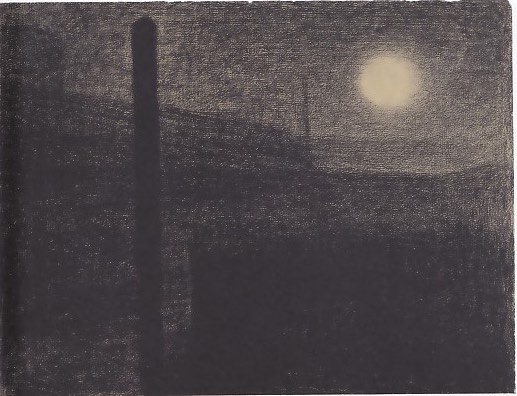Seurat’s drawings … an “esthetic of silence”
In her “Georges Seurat – The drawings,” the author Jodi Hauptman refers to Susan Sontag’s qualification of these drawings as expressing an “esthetic of silence” because of their “emptiness,” their “austerity” and “muteness,” that do not perceptually engage the onlooker, but for a dream like effect I elected to render in wet-on-wet monochromatic watercolor.
In this post, I will compare and analyze three Seurat’s crayon on textured paper drawings and my own wet-on-wet monochromatic watercolor on textured paper sketches, in terms of the above mentioned expressive qualities that seem to fit the mood of the times!
Sketching Seurat’s “Factories by moonlight”, 1882-83”

From pitch black to paper beige the depth in the drawing above is produced by degrees of decreasing tones, made possible by Seurat’s use of crayons on a highly textured paper, to produce the effect of black industrial buildings, barely profiled against vaguely receding, lighter toned, land masses under hazy moon light.
In my watercolor sketch, below, the feeling of depth is barely suggested by the opposition of the frontal dark masses and the distant moon, with little in between. The bleeding at the edges of the dark masses ignores their delineated profile, evoking something immaterial and dream like.

Sketching Seurat’s “Trees by a road”, 1881-82

Seurat’s intermediate horizon, in the drawing above, grouping the sketch darkest tones of trees, building and hedge, hides the distant one, allowing the rising and curving roadway to seem to mirror the sky.
In my watercolor sketch, below, I have framed the roadway with dark masses of vegetation giving the impression that the roadway is rising but, rather than turning, penetrates the intermediate horizon, moving on behind it.
The general darker tone of the foreground spatially unites it while narrowing the roadway, reducing its perceptual impact.

Sketching Seurat’s “Railroad tracks”, 1881-1882

In Seurat’s drawing above, we note his mastery of the crayon technique over textured paper to suggest a shiny ground cover material covering the bluff on the right of the barely distinguishable railroad tracks, and the fullness of tree foliage, on its left.
The parallel strings of telegraph poles and the distant viaduct across the tracks are the only items specific to railroad track infrastructure, delicately uniting the sharply contrasted tonal areas of bluff and sky.
In my watercolor sketch below, trees, poles and track provide the only elements with some perceptual solidity, so to speak, as the lighter toned bluff seems to dialogue with the sky instead of carrying the tracks.
Doing so, in part because of the wet on wet medium, I have reversed the perceptual scheme of Seurat’s drawing unwittingly creating something of nightmarish scene of desolation … the mood of the times?

End word
Rendering bona fide artwork in pen and ink sketches has been a recurring type of activity to hone my eye-hand relationship, the eye seeing and the hand interpreting, as a mean of creatively enriching my “visual culture”.
I trust the reader will pick some of it here.
Credit
Seurat’s drawings were taken from:
Kauptman, Jodi: GEORGES SEURAT – THE DRAWINGS, Moma, New York, 2007-2008
All watercolor sketches by Maurice Amiel
